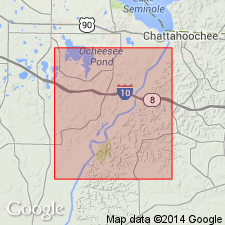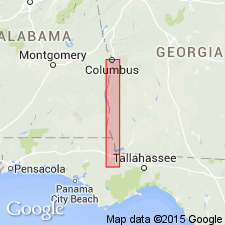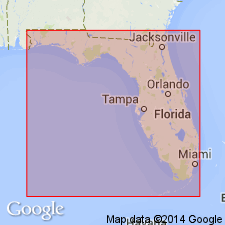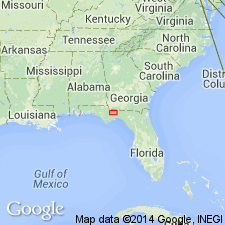
- Usage in publication:
-
- Chattahoochee group
- Modifications:
-
- Original reference
- Dominant lithology:
-
- Limestone
- AAPG geologic province:
-
- South Georgia sedimentary province
Summary:
Pg. 322-324. Chattahoochee group. Southward from Rock Island, 9 miles by water, above Chattahoochee or River Junction, Florida, the white orbitoidal limestone disappears, and in lieu thereof there is a rock more argillaceous and siliceous in character resembling some phases of Eocene Buhrstone. This limestone is very well developed in a railroad cut about 0.5 mile east of Chattahoochee River, Ocheesee, 15 miles below railroad bridge, and again at Rock Bluff, 2 miles below Ocheesee section at Ocheesee, Florida.
1. Argillaceous limestone, greenish yellow. No fossils seen. 10 feet.
2. A purer, more granular limestone, creamy white and soft, resembling "chimney rock" phase [Marianna limestone] of Vicksburg group. Contains few obscure corals to water's edge, 5 feet.
Rock Bluff, about 30 feet high, is made up of strata of limestone varying in purity, as at Ocheesee. For this older member of Miocene or newest member of Eocene White limestone, writer suggests provisional name Chattahoochee group. Only fossils found were a large Pecten about 3 inches by 3.5 inches and an oyster resembling very closely our OSTREA VIRGINICA. This group, estimated to be 250 feet thick, differs materially in lithologic characteristics from any phase of White limestone yet observed in Alabama or Mississippi. On the rich black loam, derived from disintegration of these slightly phosphatic limestones, the unique TORREIA TAXIFOLIA or "Stinking Cedar" is found growing. [Age is early Miocene. Recognized in Florida and extreme southern part of Georgia.]
Source: US geologic names lexicon (USGS Bull. 896, p. 404-405).

- Usage in publication:
-
- Chattahoochee series
- Chattahoochee group
- Modifications:
-
- Revised
- AAPG geologic province:
-
- South Georgia sedimentary province
Summary:
Pg. 97. Chattahoochee series. Argillaceous and sandy limestone alternating with strata of purer character. Contains a Pecten and an Ostrea very close to our recent VIRGINICA. This may be termed Chattahoochee group, as it is well developed there and along east river bank for next 10 miles. Thickness 25 [250] feet. Underlies Alum Bluff series and overlies White limestone series. [Age is early Miocene.]
[Same description is given by Langdon in GSA Bull., v. 2, p. 604, 605, 1891, except Chattahoochee limestone is used instead of series or group, and on p. 604 the thickness is stated to be 25 feet, but on p. 605 it is given as 250 feet.]
Source: US geologic names lexicon (USGS Bull. 896, p. 404-405).

- Usage in publication:
-
- Chattahoochee formation
- Modifications:
-
- Revised
- AAPG geologic province:
-
- South Georgia sedimentary province
Summary:
Chattahoochee formation. Limestones, marls, and some chert, 100 to 250 feet thick, underlying Alum Bluff formation [group] in western Florida and unconformably overlying Vicksburg group. Considered contemporaneous with Tampa formation of southern Florida. [Age is early Miocene.]
[Misprint (US geologic names lexicon, USGS Bull. 896, p. 405): Publication date should be 1909, not 1913.]
Source: US geologic names lexicon (USGS Bull. 896, p. 404-405).

- Usage in publication:
-
- Chattahoochee Formation
- Modifications:
-
- Areal extent
- AAPG geologic province:
-
- South Georgia sedimentary province
Summary:
The Chattahoochee is composed of the early Miocene updip, generally silty, clayey, and dolomitic terrigenous and shallow water sediments, while the time equivalent St. Marks includes the offshore, calcareous, downdip facies. These facies interfinger in central and eastern Gadsden Co. The Chattahoochee is generally a silty to sandy dolomite, with some limestone. Unit is 200 ft thick in a well southeast of Chattahoochee. The upper 130 ft is composed of white, unfossiliferous sandy limestone; the lower 70 ft is a light orange to grayish orange, unfossiliferous dolomite. Because of the interbedding, formational picks were not made in the transitional area. Interval overlies the Oligocene Suwannee Limestone and unconformably underlies the Miocene Hawthorn Group.
Source: GNU records (USGS DDS-6; Reston GNULEX).
For more information, please contact Nancy Stamm, Geologic Names Committee Secretary.
Asterisk (*) indicates published by U.S. Geological Survey authors.
"No current usage" (†) implies that a name has been abandoned or has fallen into disuse. Former usage and, if known, replacement name given in parentheses ( ).
Slash (/) indicates name conflicts with nomenclatural guidelines (CSN, 1933; ACSN, 1961, 1970; NACSN, 1983, 2005, 2021). May be explained within brackets ([ ]).

